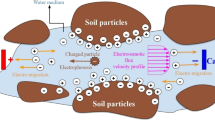Abstract
Experimental results obtained to date indicate electrokinetic extraction is viable in removing organic and inorganic contaminants from fine-grained soils. However, electrochemical reactions and soil-contaminant interactions that occur simultaneously may enhance or reduce the removal efficiency of the hazardous waste site remediation process. Many sites worldwide are contaminated by lead and its compounds, resulting in lead poisoning. It is difficult to remove lead from fine-grained soil because of the existence of a great variety of lead complexes and their pH-dependent and reversible physicochemical properties. The feasibility of electrokinetic extraction of lead from kaolinites is investigated theoretically, numerically, and experimentally in this study. This is the first paper of two companion papers presenting the theoretical and numerical modeling of the transport of lead species, and electrochemical reactions and soil-contaminant interactions occurring during the electrokinetic extraction process. The comparison between simulation results and experimental results is presented in the second paper.


Similar content being viewed by others
References
Acar YB, Hamed JT, Alshawabkeh A, Gale RJ (1994) Cd(II) removal from saturated kaolinite by application of electrical current. Géotechnique 44(3):239–254
Araki S, Sato H, Yokoyama K, Murata K (2000) Subclinical neurophysiological effects of lead: a review on peripheral, central, and autonomic nervous system effects in lead workers. Am J Ind Med 37(2):193–204
Carroll-Webb SA, Walther JV (1988) A surface complex reaction model for the pH independence of corundum and kaolinite dissolution rates. Geochim et Cosmochim Acta 52(11):2609–2623
Ellis WD, Fogg TR, Tafuri AN (1986) Treatment of soils contaminated with metals. In: Proceedings of 12th annual res symposium: land disposal, remedial action, incineration and treatment of hazardous waste. Report No. EPA/600/S9-86/022, U.S. EPA, Cincinnati, pp 201–207
Eykholt GR, Daniel DE (1994) Impact of system chemistry on electroosmosis in contaminated soil. ASCE J Geotech Eng 120(5):797–815
Goodisman J (1987) Electrochemistry: theoretical foundations, quantum and statistical mechanics, thermodynamics, the solid state. Wiley, New York
Jensen PE, Ottosen LM, Harmon TC (2007) The effect of soil type on the electrodialytic remediation of lead-contaminated soil. Environ Eng Sci 24(2):234–244
Kaufmann RB, Staes CJ, Matte TD (2003) Deaths related to lead poisoning in the United States, 1979–1998. Environ Res 91(2):78–84
Mitchell JK, Yeung AT (1991) Electro-kinetic flow barriers in compacted clay. In: Geotechnical engineering 1990, Transp. Res. Rec. 1288, Transp. Res. Board, Washington, DC, pp 1–9
Ogawa M, Nakajima Y, Kubota R, Endo Y (2008) Two cases of acute lead poisoning due to occupational exposure to lead. Clin Toxicol 46(4):332–335
Pamukcu S, Wittle JK (1992) Electrokinetic removal of selected heavy metals from soil. AIChE Environ Prog 11(3):241–250
Reith DM, O’Regan P, Bailey C, Acworth J (2003) Serious lead poisoning in childhood: still a problem after a century. J Paediatr Child Health 39(8):623–626
Rutigliano L, Fino D, Saracco G, Specchia V, Spinelli P (2008) Electrokinetic remediation of soils contaminated with heavy metals. J Appl Electrochem 38(7):1035–1041
Sakai T (2000) Biomarkers of lead exposure. Ind Health 38(2):127–142
Stumm W, Morgan JJ (1996) Aquatic chemistry: chemical equilibria and rates in natural waters, 3rd edn. Wiley, New York
van Olphen H, Fripiat JJ (eds) (1979) Data summaries—clay minerals society. In: Data handbook for clay materials and other non-metallic minerals. Pergamon Press, New York, pp 13–37
World Health Organization (1995) Environmental health criteria for inorganic lead. Environmental Health Criteria Monograph 165. WHO, Geneva. Available at http://www.inchem.org/documents/ehc/ehc/ehc165.htm. Accessed 23 Aug 2009
Yang GCC, Lin SL (1998) Removal of lead from a silt loam soil by electrokinetic remediation. J Hazard Mater 58(1–3):285–299
Yeung AT (1990) Coupled flow equations for water, electricity, and ionic contaminants through clayey soils under hydraulic, electrical and chemical gradients. J Non Equilib Thermodyn 15(3):247–267
Yeung AT (1992) Diffuse double-layer equations in SI units. ASCE J Geotech Eng 118(12):2000–2005
Yeung AT (1994) Electrokinetic flow processes in porous media and their applications. In: Corapcioglu MY (ed) Adv porous media, vol 2. Elsevier, Amsterdam, pp 309–395
Yeung AT (2006a) Contaminant extractability by electrokinetics. Environ Eng Sci 23(1):202–224
Yeung AT (2006b) Fundamental aspects of prolonged electrokinetic flows in kaolinites. Geomech Geoengin An Int J 1(1):13–25
Yeung AT (2008) Electrokinetics for soil remediation. In: Yeung AT, Lo IMC (eds) Environmental geotechnology and global sustainable development 2008. Advanced Technovation Ltd, Hong Kong, pp 16–25
Yeung AT (2009a) Remediation technologies for contaminated sites. In: Proceedings of international symposium geoenvironeng (ISGE 2009), Hangzhou, pp 328–369
Yeung AT (2009b) Geochemical processes affecting electrochemical remediation. In: Reddy K, Cameselle C (eds) Electrochemical remediation technologies for polluted soils, sediments and groundwater. Wiley, New York, pp 65–94
Yeung AT, Datla S (1995) Fundamental formulation of electrokinetic extraction of contaminants from soil. Can Geotech J 32(4):569–583
Yeung AT, Hsu C (2005) Electrokinetic remediation of cadmium-contaminated clay. ASCE J Environ Eng 131(2):298–304
Yeung AT, Mitchell JK (1993) Coupled fluid, electrical, and chemical flows in soil. Géotechnique 43(1):121–134
Author information
Authors and Affiliations
Corresponding author
Rights and permissions
About this article
Cite this article
Yeung, A.T., Hsu, Cn. & Menon, R.M. Electrokinetic extraction of lead from kaolinites: I. Numerical modeling. Environmentalist 31, 26–32 (2011). https://doi.org/10.1007/s10669-010-9295-4
Published:
Issue Date:
DOI: https://doi.org/10.1007/s10669-010-9295-4




